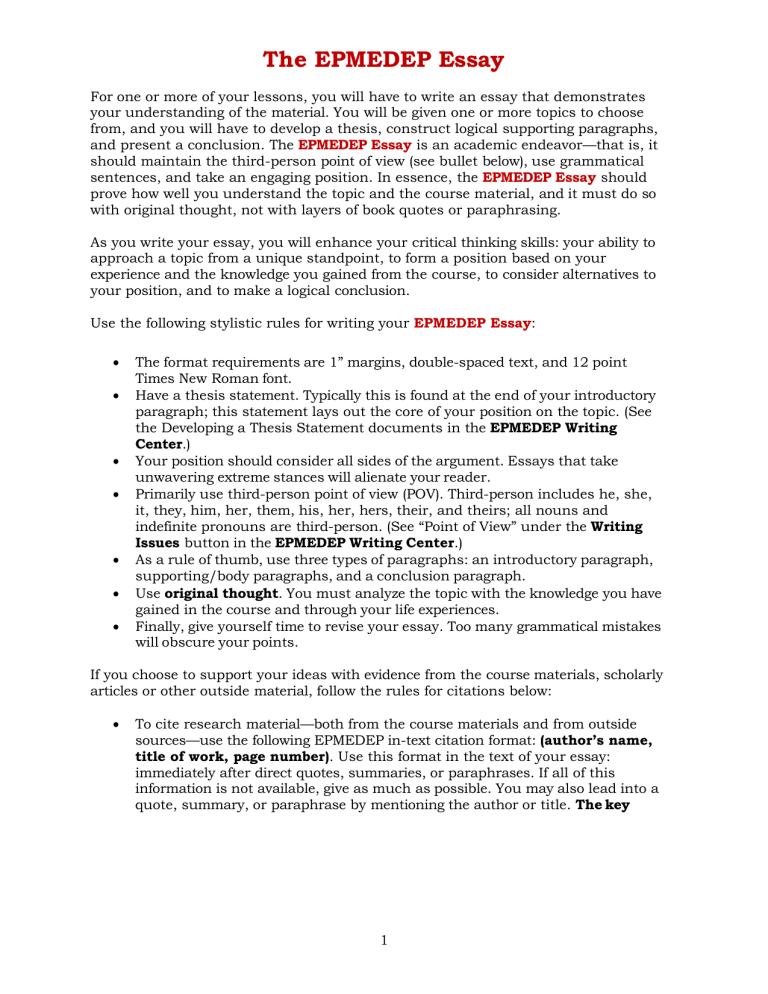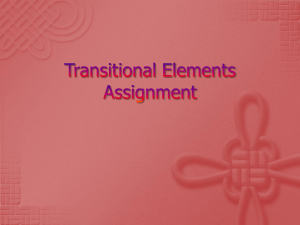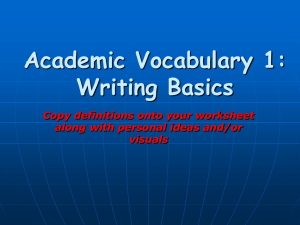
The EPMEDEP Essay For one or more of your lessons, you will have to write an essay that demonstrates your understanding of the material. You will be given one or more topics to choose from, and you will have to develop a thesis, construct logical supporting paragraphs, and present a conclusion. The EPMEDEP Essay is an academic endeavor—that is, it should maintain the third-person point of view (see bullet below), use grammatical sentences, and take an engaging position. In essence, the EPMEDEP Essay should prove how well you understand the topic and the course material, and it must do so with original thought, not with layers of book quotes or paraphrasing. As you write your essay, you will enhance your critical thinking skills: your ability to approach a topic from a unique standpoint, to form a position based on your experience and the knowledge you gained from the course, to consider alternatives to your position, and to make a logical conclusion. Use the following stylistic rules for writing your EPMEDEP Essay: The format requirements are 1” margins, double-spaced text, and 12 point Times New Roman font. Have a thesis statement. Typically this is found at the end of your introductory paragraph; this statement lays out the core of your position on the topic. (See the Developing a Thesis Statement documents in the EPMEDEP Writing Center.) Your position should consider all sides of the argument. Essays that take unwavering extreme stances will alienate your reader. Primarily use third-person point of view (POV). Third-person includes he, she, it, they, him, her, them, his, her, hers, their, and theirs; all nouns and indefinite pronouns are third-person. (See “Point of View” under the Writing Issues button in the EPMEDEP Writing Center.) As a rule of thumb, use three types of paragraphs: an introductory paragraph, supporting/body paragraphs, and a conclusion paragraph. Use original thought. You must analyze the topic with the knowledge you have gained in the course and through your life experiences. Finally, give yourself time to revise your essay. Too many grammatical mistakes will obscure your points. If you choose to support your ideas with evidence from the course materials, scholarly articles or other outside material, follow the rules for citations below: To cite research material—both from the course materials and from outside sources—use the following EPMEDEP in-text citation format: (author’s name, title of work, page number). Use this format in the text of your essay: immediately after direct quotes, summaries, or paraphrases. If all of this information is not available, give as much as possible. You may also lead into a quote, summary, or paraphrase by mentioning the author or title. The key 1 The EPMEDEP Essay point here is to give the author/source credit and to show where your research came from. A “works cited” or reference page at the end of the essay is not needed. Footnotes or endnotes in the essay are not needed. IMPORTANT: Although you must cite any sources you use to support your ideas, the EPMEDEP Essay does not require the use of outside sources. If your essay is filled with quotes and footnotes with little of your own analysis or evaluation, then the work will not meet the intent of the EPMEDEP Essay. The key is to only use research material to present facts or points that support your original ideas. Further, if you use direct quotes or paraphrasing, you must analyze or explain how the material supports your position. Here are two examples of acceptable in-text citations for quotations in the EPMEDEP Essay: 1. In the opening line, “It was the best of times, it was the worst of times…” the author illustrates the state of affairs after the French Revolution (Dickens, A Tale of Two Cities, pg.1). 2. Kurtz’s final words in Joseph Conrad’s Heart of Darkness, “The horror! The horror!”(pg.180) intend to convey the brutality of war. Here are three examples of acceptable in-text citations for paraphrasing information in the EPMEDEP Essay: 1. During the Boxer Rebellion, Smedley Butler was shot in one of his uniform buttons, scarring his Marine Corps chest tattoo (Talbot, Devil Dog, pg. 44). 2. On the final page of Flannery O’Connor’s story, “A Good Man is Hard to Find,” the character named The Misfit tells the grandmother that there is no pleasure in our existence. 3. Gordon and Trainer (2006) state that the opening air and ground attacks of Operation Iraqi Freedom were meant to mislead and confuse Iraqi military leaders (pg. 227). When in doubt, cite the source. Keep in mind, if you did not write the material yourself (i.e., from your original thoughts or without outside information), or if quotation marks are used to show someone else has written or said something, attribution must be given in some way or else this is considered plagiarism. Include as much of the required information as you can to show your reader how to find the source of the information. If a source is so obscure that its basic info is unavailable, question the source’s validity or search for some form of identification; even a URL, short description, or partial name will work. 2 The EPMEDEP Essay Example Format Introductory paragraph: This paragraph should be 3-5 sentences in length, and the last sentence of the paragraph should be your thesis statement. This paragraph should be the blueprint of your essay, introducing the subject you are writing about, answering the essay question in plain language, and it should say why you came to that answer to the question. Body paragraph 1: This paragraph should address one aspect of your thesis statement (which means one aspect of your answer to the essay question), and it should begin with a topic sentence (For example: The M1 Abrams tank changed the face of armored ground warfare). The next two sentences in this paragraph should support the topic sentence (For example: The M1 Abrams’ multifuel turbine engines almost doubled the speed of the previous model, the M60. Also, the composite armor of the M1 tremendously improved crew safety.) This paragraph should conclude with a summary of the topic of this paragraph, and it should transition into the next paragraph. (For example: While the M1 Abrams revolutionized armored ground warfare, its upgrades such as the M1A1 and M1A2 further enhanced armor, night vision capabilities, and CBRN protection systems.) Body paragraph 2: This paragraph should address one aspect of your thesis statement (which means one aspect of your answer to the essay question), and it should begin with a topic sentence. The next two sentences in this paragraph should support the topic sentence. This paragraph should conclude with a summary of the topic of this paragraph, and it should transition into the next paragraph. 3 The EPMEDEP Essay Body paragraph 3: This paragraph should address one aspect of your thesis statement (which means one aspect of your answer to the essay question), and it should begin with a topic sentence. The next two sentences in this paragraph should support the topic sentence. This paragraph should conclude with a summary of the topic of this paragraph, and it should transition into the next paragraph. Conclusion paragraph: This paragraph should use 2-5 sentences to restate the answer to the essay question, say why you came to that conclusion, and it should summarize how you supported that conclusion. 4


